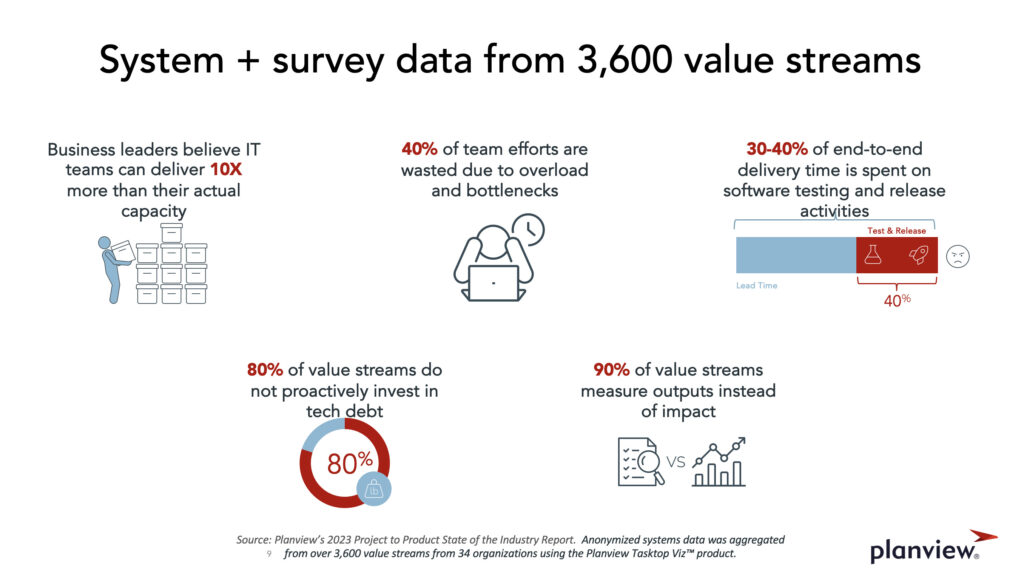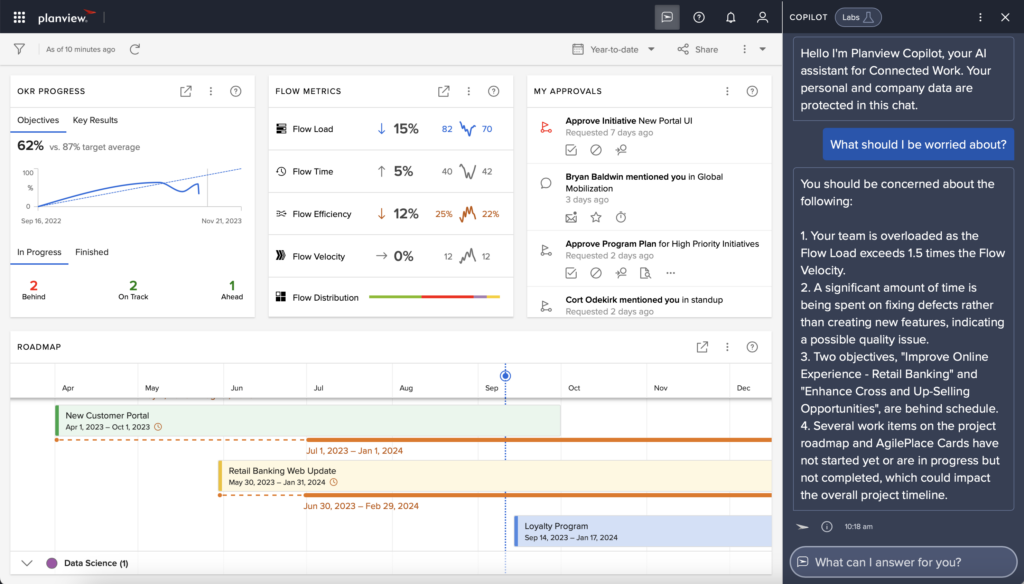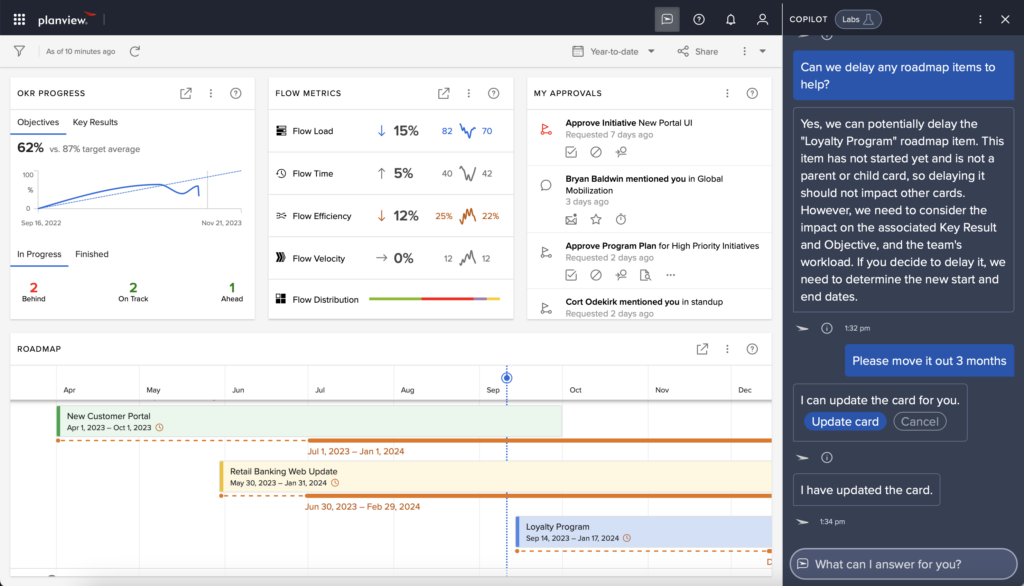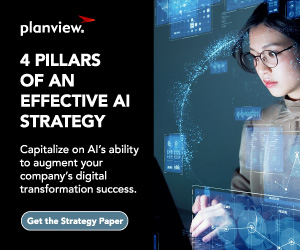
AI is further accelerating the pace of disruption and widening the gap between digital leaders and laggards. At Planview, our mission is to build the future of Connected Work, where the world’s organizations can innovate at the speed of a startup.
The past decade of digital transformation has made it clear how difficult innovating at speed can be for organizations mired in legacy systems, technical debt, and disconnected decision making.
Today’s announcement of Planview Copilot marks what we see as the start of a step function improvement in turning established organizations into digital innovators.
The bottleneck on digital innovation is no longer access to new technology. Thanks to the success of open source and cloud, the same technological foundations used by the most successful innovators are available to all organizations. The software development methodologies and organizational design principles harnessed by digital natives are well documented. The latest advances in generative AI and Large Language Models (LLMs) have become ubiquitously available at an unprecedented rate.
So why is it that some organizations are so good at leveraging the cutting edge of digital innovation while others continue to spin up one flawed transformation initiative after another? Put another way, why do some organizations exhibit 10x more digital intelligence than others?
Quantifying the Disconnect Between Business Leaders and Technology Teams
Consider one of the most startling findings from The 2023 Project to Product State of the Industry Report. In this study covering thousands of value streams under management, we baselined the capacity of enterprise organizations’ value streams by measuring the flow of value through software development tools (e.g., how much value development teams delivered to customers over the course of a planning cycle).
We then contrasted that with survey data on what those organizations’ business leaders thought the teams’ capacity was. What we found was that business leaders believe technology teams can deliver approximately 10x more than the capacity that was measured.

These results were eye-opening. Did these organizations hire thousands of distracted developers who spend the day watching videos instead of working? No. It turns out that overload, tech debt, and dependencies are thwarting developers’ ability to deliver value.
Are the business leaders in these organizations so inept that they deliberately overload development teams with work that there is no capacity to do? No, but there is a lack of visibility and meaningful measurement of development capacity during strategic planning as the two processes are completely disconnected.
An observer accustomed to understanding the importance of matching capacity to demand – say, a manufacturer of cars or cloud compute capacity – would assume such an organization to be functioning very unintelligently regardless of how intelligent the individuals in the organization are.
Yet our study clearly shows that, despite these shortcomings, the data is there for the organization to make the right decisions. Given that we were able to create the correlations in the data that drove these findings, is there a way that we can make these insights visible and actionable in the course of day-to-day work? How can we leverage the profound analytical power of the largest LLMs to enhance your organization’s digital intelligence?
Leveraging AI at the Organizational Level
In terms of navigating through the digital landscape, I can no longer imagine getting through the day without repeatedly drawing on the intelligence of GPT-4, which has augmented my effective intelligence. Similarly, I cannot imagine taking the productivity benefits of GitHub Copilot away from dev teams. The LLM-based code completion, generation, and information access that it provides to every developer increases their output as well as their job satisfaction.
However, there is a limit to how much an organization can gain from individual solutions like these. How can we leverage AI to achieve similar gains not only at the level of individual contribution but also at the organizational level? Our product, data science, and AI teams have been working on the answer to this question for over a year, and we are finally ready to share our results.
In the world of connected work, digital intelligence requires connected data – curated, structured, and unstructured data spanning from ideate to operate and organized using meaningful ontologies.
Planview customers have access to this data thanks to our industry-leading portfolio, enterprise agile, and value stream management offerings. Today, that data set constitutes over two million users across 4,500 customers’ planning, project, and product management solutions, along with all the team tools connected via the Flow Fabric™, a technology that extends our connectivity to all leading Agile and DevOps and team tools.
The longevity and breadth of the Planview product portfolio, combined with all the customer usage, support, methodology documentation, and the Machine Learning (ML) models we have created over the years, add up to what we have been internally calling the System of Record for Digital Transformation.
Once we figured out how to connect, curate, and contextualize these data for use by LLMs including GPT-4 and Claude 2, we realized we were sitting on a solution that could instantly add a whole new layer of intelligence to digital transformation.
Generating Strategic Insights Quickly
To make this concrete, assume that I am a seasoned executive at an enterprise organization but only have a cursory knowledge of the concepts of flow, lean, and Agile that my teams use for planning. We have a critical initiative of launching a new customer portal that I just heard may be at risk of falling behind. I bring up Planview, which has Roadmaps, Objectives and Key Results (OKRs), and Flow Metrics tailored to exactly what I am interested in.
However, I know that there is a lot of data behind what I am seeing, and while I am familiar enough with this view to see that two objectives are behind, I am not sure what to do about this without seeking the expertise of multiple functional leaders. Instead of scheduling those meetings, I simply ask Planview Copilot: “What should I be worried about?”

Now we see the magic happen. Planview Copilot has indicated that the team is overloaded because the team’s Flow Load (how much work the team currently has in progress) is 1.5x greater than its Flow Velocity (the real-time metric of the team’s delivery capacity).
While I may not be familiar with the queuing theory that is behind this analysis, Planview Copilot has access to the value stream management theory, as well as my teams’ historical data, and is able to predict and explain in plain language that the team is likely to miss their commitments. It also goes into more detail, showing that quality problems in the product are increasing and that other objectives are behind schedule.
While I may have been able to deduce this by clicking around for an hour, sending a dozen Slack messages, and scheduling several meetings, it took just a few seconds for Planview Copilot to present me with this information based on real-time data. In terms of support for strategic decision making, it is expanding my effective intelligence in a very easy-to-use and accessible way.
Analyzing Insights and Recommending Actions
This support does not stop at strategic insights. We have added agent capabilities to Planview Copilot to go from insights to actions. The insight provided me with guidance on where the capacity problems are coming from. But I still have the critical need of getting the New Customer Portal delivery done on time for the planned launch.
I can ask Planview Copilot what we can do in terms of freeing up capacity on the roadmap. When I do that, it instantly recommends pushing out the Loyalty Program roadmap item. While seemingly simple, the sophistication of that recommendation will be familiar to anyone who has spent time managing digital product development.
Planview Copilot was able to analyze the dependencies and start dates of the various initiatives that are underway and backed by the knowledge of software team productivity, and the Flow Framework® was able to determine that this would be the least disruptive change to the overall plan. Planview Copilot then offers to automatically push out that roadmap item for me and then to communicate this change to my teams via the tools they work in, completely closing the loop.

This is just one example of a single persona interacting with Planview Copilot. Our goal is for everyone leading and supporting teams, products, and portfolios to have this outboard brain at their fingertips. By building this solution on our completely unique data set and models, we have been able to build into Planview Copilot a kind of intelligence that we could not have imagined a year ago. That intelligence is highly accessible through a conversational interface in your language of choice.
Most exciting of all is that, when adopted across company functions and teams, we believe that this is the start of not only elevating and amplifying the effectiveness of all the people leveraging this innovation, but in transforming the collective intelligence of your entire organization. And we are committed to doing this in a way that protects your data, based on our approach to responsible AI.
What’s Ahead for Planview Customers
Today we are announcing a limited release of Planview Copilot to select customers, and we will expand that group over the coming weeks. For those of you as excited about the prospects of this as we are, there are two things you can do today.
First, Planview Copilot is only as effective as the data that it has access to. For it to have these transformational effects, the team, planning, and portfolio tools you are using need to be connected right down to the work item and artifact level. If your OKRs, roadmaps, or strategic initiatives are not bi-directionally connected, now is the time to connect strategy to delivery.
Second, we would be thrilled for those of you who share our vision to join our Planview Copilot Inner Circle.
Additionally, you can always contact your Planview representative if you’d like more information. Stay in touch, and help us define the future of connected work!




